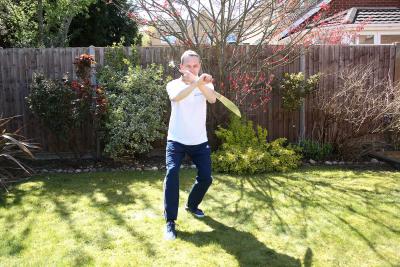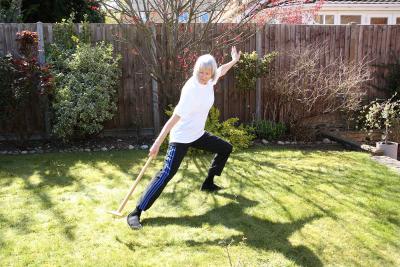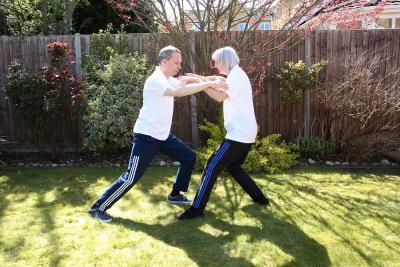- Have any question?
- Mobile 07585 809667
- info@spaldingpodiatry.co.uk
The Tai Chi Lineage
Short Form
Long Form Part 1
Broadsword
Dao-Chun up to Fist Under Elbow
The Tai Chi Lineage As Taught To Us By Master Bob Fermor
The Yang Tai Chi that we currently practise and teach as taught to us by Master Bob Fermor and his senior student Dave Watts is very close to the founder Yang Chen Fu. Bob holds the Lineage from his teacher Master Deng Er Qian. Master Deng who in turn was taught by his father and his father directly by Yang Chen Fu. This confirms that the Tai Chi we have been taught is very close to the founder Yang Chen Fu. Bob says that Master Deng had that magical quality in his teaching that he always looks for in a teacher. He was an outstanding teacher and martial artist in his own right who could do Tai Chi as an applied fighting art. Bob says that this is actually quite rare in a teacher of Tai Chi.
Yang Short Form
 The Yang short form helps to reinforce all the other forms. All the movements can be applied in push hands, or done as separate applications for self-defence. It is easy to learn for the beginner as the movements are, soft, gentle, flowing and are of a circular nature. There are a series of postures to learn and each posture flows into the next one. This is not a traditional form but is a great way to start your Tai Chi journey.
The Yang short form helps to reinforce all the other forms. All the movements can be applied in push hands, or done as separate applications for self-defence. It is easy to learn for the beginner as the movements are, soft, gentle, flowing and are of a circular nature. There are a series of postures to learn and each posture flows into the next one. This is not a traditional form but is a great way to start your Tai Chi journey.
Traditional 85 Yang Long Form
 The traditional 85 Yang Long Form is also known as ‘long fist’ or ‘long boxing’ it is a form that is performed very rhythmically, slowly, gently and in a beautiful flowing style. Basically, we build in a natural 4 second in breath and 4 second out breath. This way of breathing helps the individual gain a very strong root into the ground, just like a firmly planted tree. It strengthens and tones the whole body, making the body very flexible and strong, building great foundations for both health and self-defence. This way of breathing is very good for our circulation and inner workings of our body. It is important that the movements are done correctly to gain the maximum benefit from the form. Bob is very keen to ensure all the forms are taught in exactly the same way as was handed down to him by Master Deng. All the moves can be applied in push hands or for self defence purposes. Bob is a Master at being able to show and apply all the moves, both in push hands and for self-defence. The Yang 85 Long Form feeds directly into the broad sword and long sword.
The traditional 85 Yang Long Form is also known as ‘long fist’ or ‘long boxing’ it is a form that is performed very rhythmically, slowly, gently and in a beautiful flowing style. Basically, we build in a natural 4 second in breath and 4 second out breath. This way of breathing helps the individual gain a very strong root into the ground, just like a firmly planted tree. It strengthens and tones the whole body, making the body very flexible and strong, building great foundations for both health and self-defence. This way of breathing is very good for our circulation and inner workings of our body. It is important that the movements are done correctly to gain the maximum benefit from the form. Bob is very keen to ensure all the forms are taught in exactly the same way as was handed down to him by Master Deng. All the moves can be applied in push hands or for self defence purposes. Bob is a Master at being able to show and apply all the moves, both in push hands and for self-defence. The Yang 85 Long Form feeds directly into the broad sword and long sword.
Yang Broad Sword
 The first sword form to be taught after the Long Form is the Broad Sword or the Dao which is primarily a weapon for slashing or chopping. It is a traditional weapon performed in the Tai Chi style. This is a beautiful form that encourages all the elements of Tai Chi building on the foundations of the Traditional 85 Long Form.
The first sword form to be taught after the Long Form is the Broad Sword or the Dao which is primarily a weapon for slashing or chopping. It is a traditional weapon performed in the Tai Chi style. This is a beautiful form that encourages all the elements of Tai Chi building on the foundations of the Traditional 85 Long Form.
Yang Straight Sword
 The straight sword or the Jian is a double-edged sword, also known as the ‘gentleman of weapons’ which can trace it’s history back in China 2,500 years. The form is performed in the Tai Chi style. It is the most difficult of all the forms to perform. It is elegant, graceful and extremely flowing. Our teacher Bob is a Master at performing it.
The straight sword or the Jian is a double-edged sword, also known as the ‘gentleman of weapons’ which can trace it’s history back in China 2,500 years. The form is performed in the Tai Chi style. It is the most difficult of all the forms to perform. It is elegant, graceful and extremely flowing. Our teacher Bob is a Master at performing it.
Dat Mo Stick
 The Dat Mo stick is performed in the Tai Chi style it is a very old Kung Fu form that can trace its roots right back to the shaolin temple. Most stick forms are just versions of the broad sword and are not true stick forms like the Dat Mo stick. It looks very much like a crutch, so has many uses in self-defence. Master Deng won a gold medal with the Dat Mo stick form at the age of 75 in the Shanghai Championships, which is quite amazing. The Dat Mo stick has two branches the Shaolin Si and the Tagou school. It was formally named Damo after Bodhidharma himself. This form is taught by our teacher after the Long Sword but it really is not a Tai Chi form. Master Fermor who is one of the world’s greatest weapon exponents was truly honoured to be taught this form by his teacher and to be able to hand it down to us his students. The Dat Mo stick although performed in the Tai Chi style is a fantastic form for self defence as there are many ways of applying the moves. It is a fantastic form to study.
The Dat Mo stick is performed in the Tai Chi style it is a very old Kung Fu form that can trace its roots right back to the shaolin temple. Most stick forms are just versions of the broad sword and are not true stick forms like the Dat Mo stick. It looks very much like a crutch, so has many uses in self-defence. Master Deng won a gold medal with the Dat Mo stick form at the age of 75 in the Shanghai Championships, which is quite amazing. The Dat Mo stick has two branches the Shaolin Si and the Tagou school. It was formally named Damo after Bodhidharma himself. This form is taught by our teacher after the Long Sword but it really is not a Tai Chi form. Master Fermor who is one of the world’s greatest weapon exponents was truly honoured to be taught this form by his teacher and to be able to hand it down to us his students. The Dat Mo stick although performed in the Tai Chi style is a fantastic form for self defence as there are many ways of applying the moves. It is a fantastic form to study.
Push Hands
Our teacher Bob and his senior student Dave teach us that push hands is the most important out of all the forms to learn and develop, because without push hands Tai Chi will be just a form of exercise. All the movements from both the Yang 85 long form and the Yang Short form can be applied in push hands. Through this form of partner exercise, you will learn to soften the body to an even greater level, stick and adhere to your partner. It is important to develop really good listening skills to sense what your partner is doing and to follow them. Push hands is vital to learn as it makes Tai Chi a real Martial Art. Push hands is safe, fun and a real joy to learn. It is important to remember that there are deeper and deeper levels of relaxation, push hands is brilliant to develop this. If the body is stiff and not relaxed it can easily be exploited by someone that is adept at push hands. Bob and Dave are renowned not only for their forms but also for their pushing hands ability.


Applications
 All the movements from either the short form or the Traditional 85 Long Form can be applied for both self-defence and in push hands. Our teacher Bob is always keen to show us how the moves can be applied either in push hands or for self-defence. The moves must be applied in exactly the same way as the form is performed. This really helps to reinforce the movement as a Martial Art.
All the movements from either the short form or the Traditional 85 Long Form can be applied for both self-defence and in push hands. Our teacher Bob is always keen to show us how the moves can be applied either in push hands or for self-defence. The moves must be applied in exactly the same way as the form is performed. This really helps to reinforce the movement as a Martial Art.
A Note From Shotokan Karate Master Nick Adamou (9th Dan)
A few years ago I performed a Kata and did a video of myself performing it. I sent a copy to my old Shotokan Karate teacher Nick Adamou (9th Dan). A former senior student of the great Master Hirokazu Kanzawa (10th Dan). Nick has taught all over the world and has run his own Karate Association for many years. The last time that he saw me perform Karate movements, I had nearly died in a very bad car accident and sustained a very bad back injury. After nearly 20 years of Tai Chi, Qigong, Meditation and Healing my back is so much better. I thought it prudent to send my teacher a video and see what he thought? I was delighted at his reply!!
Below is a statement about my Karate performance made by Shotokan Karate Master Nick Adamou (9th Dan) some 25 years after I had to give up Karate due to my severe injury:-
 Dear Gary,
Dear Gary,
I’ve been thinking a lot about all that I wrote regarding your kata performance on the memory stick and I realise that I did my utmost not to be too emotional. Bearing this in mind I really have to say that your kata and the way you performed those karate techniques within it were really very good. I was especially impressed with your punches and also your front kicks. Well done Gary on retaining such an understanding of these techniques that you learnt and practiced so long ago whilst adding to them at this point in time way in the future, a ‘youthfulness’ and better way of performing them than you were ever able to do when you were younger. Brilliant and thank you.
Kind regards.
Nick
